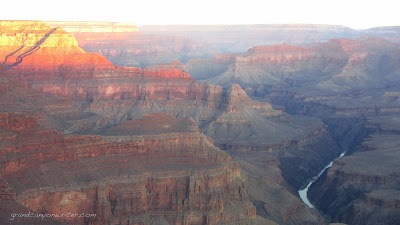 |
| Looking west at Pima Point |
I had driven out to Pima Point, about seven miles west of Grand Canyon Village. The place was empty. The entire road there—empty. Heaven, I thought.
The sun was just a rose glow to the east as I left my car and put on my gloves and walked to the cliff edge. Pima Point offers one of the best views of the Colorado River from the South Rim. From there I could see and hear Granite rapids, a class 8 rollar-coaster which I had rafted just five months earlier.
It was was a beautiful morning. Cold, cloudless, not a voice to be heard. Not a car, not a plane. So I sat on a rock, my legs tucked beneath me and watched the sky turn that pale peach color I associate with babies’ palms. Soft. Wondrous. And within a little while the sun crested the eastern ridge, and hit the canyon walls, igniting them into colors I associate with the the Colorado Plateau: Kaibob Limestone, Coconino Sandstone, Hermit Shale. Twenty distinct layers of different aged stone dropping lower and lower until until they reach the canyon’s roots: 1.8 billion year old schists and granites named after Vishnu and Zoroaster.
And just as I was thinking how grateful I was to have this quiet place all to myself, up come two cars filled with tourists. And I thought, well, whoever it is that is now opening their doors and slamming them shut, whoever it is that is parenting those screaming kids, whatever person has just hit their key-fob so that the car’s horn just beeped, and now beeps again and then again, that those people, once they see this site and see me posed like Siddhartha, that they will understand. This is a time for silence. For veneration. For grace.
I was wrong.
They ran, skipped, jumped down the path, laughing, talking so loud you’d think it was mid-day at a football game. Not one single second of quiet ensued. The group shouted about this, and shouted about that, and then for a good three minutes – they shouted and shouted and shouted into the canyon, trying their best to launch an echo off those ancient walls.
Had we spoke the same language, I might have told them that if they were quiet they could hear the river. I imagined miming my message. A finger in front of my lips, a hand cupped to my ear, and then pointing to the white water below. But I felt so frustrated with them, so disappointed and annoyed that what I really wanted to do was just yell right back at them. Shut the hell up!
Silence. What a treasure. And how easy it is to quash. It happens so regularly, trumping silence for the noice of our cars, our music our voices.
There is a wonderful interview on the web entitled How Silence Works, Emailed Conversations with Four Trappist Monks. Trappists follow a “vow of silence,” speaking very rarely, and briefly when they do. When asked what silence adds to their lives, one monk said.
 |
| Looking North at Pima Point |
Reading this I understood why I was so frustrated with this morning’s interlopers. Had they approached the canyon like a temple, rather than an amusement park, had they realized they were in the presence of a shrine older and grander than anything built by man, had they given the canyon the “silence of adoration,” then we might have arrived at “a deep communion.” One that would not have needed a common language, but instead feathered itself in the down of our reverence.
Hello dear Naseem! While I understand your frustration at the interlopers, they were obviously on quite a different path (however close) than you! "They ran, skipped, jumped down the path, laughing, talking so loud you'd think they were in a crowd of a hundred people" You could choose to be affronted — OR, amazing novelist that you are, you could look at this as an opportunity to jump into their POV. What were they doing there? Who were they? What's their story?
Sometimes I think we get unexpected gifts from the outside world. We just don't recognize them as such …
Sending you huge love from Oregon!
xx Kimberly
Naseem – I agree with you completely! Silence, respect and awe…. a former long time Grand Canyon resident.
I especially like "On Not Being Able to Get Out of my Car" (Capturing the moment, the anticipation of a life-changing adventure) and "That's How Big the Grand Canyon Is" (New perspectives that add to my appreciation of the immensity of the Grand Canyon, with a hint of humor at the end).
Both pieces inspire me to look around, to reflect, and to write. Thank you.
Debi B.
Naseem, Thanks for sharing. I fully understand your frustration. One way I try to find good in it is to think about the positive aspect of the intrusion. Part of why we appreciate the silence is because of how rare it is. The noise gives contrast, and allows you to appreciate the quiet.